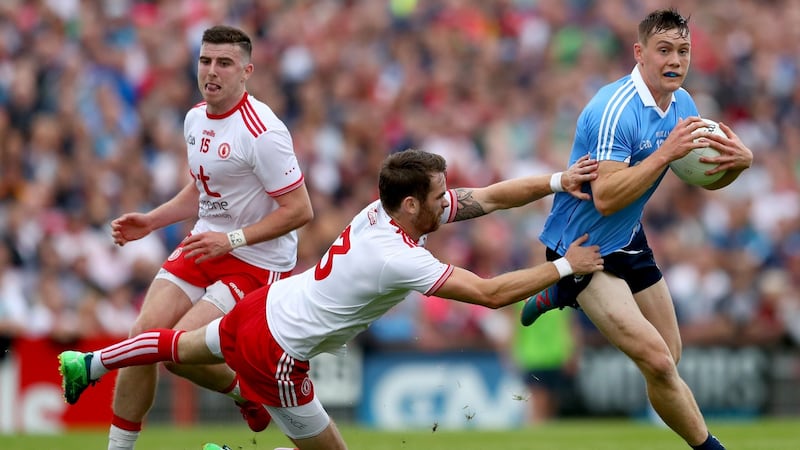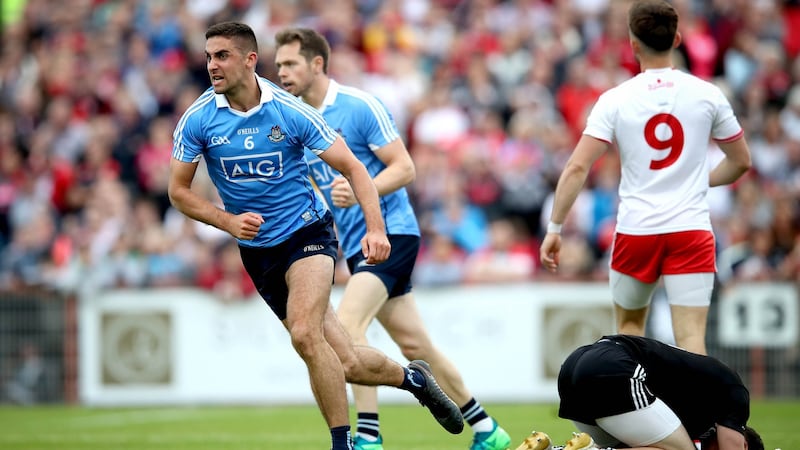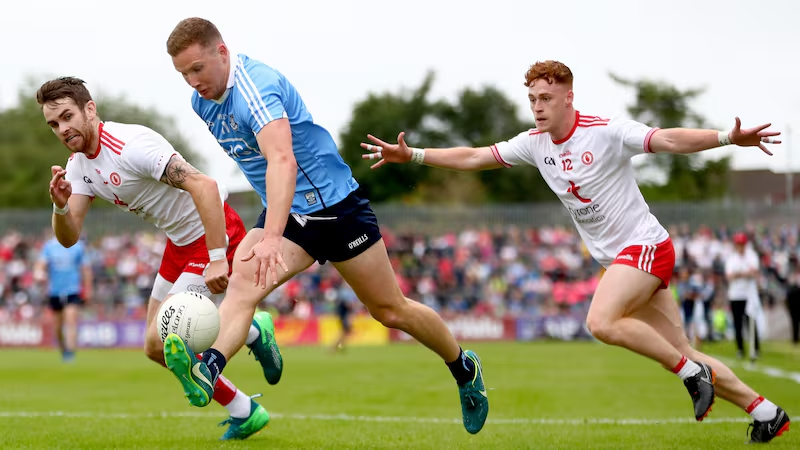Here's how it was, or how we thought it was. In the RTÉ studio before last year's All-Ireland semi-final between Dublin and Tyrone, there was a discussion about whether or not Jim Gavin would start Diarmuid Connolly.
It was Brolly, it was Spillane, it was O’Rourke and your interest in what they had to say will, of course, be governed by your own particular taste. At this remove, it doesn’t matter whether they were right or wrong, what matters is how they framed what they were about to see.
They kicked it around this way and that and broadly came down in favour of Dublin welcoming Connolly back from suspension and throwing him into the fray immediately. Brolly reckoned it was worth moving Con O'Callaghan out to the wing to take a little pressure off him, sticking Connolly in the middle and having Paddy Andrews make way. The final word went to Spillane, who was unequivocal on the issue.
“I would start Diarmuid for two reasons,” he said. “I think he is the ideal man to counteract Tyrone. One, he is a powerful strong runner who can break through tackles. But secondly, and more importantly, he is a brilliant long-range point-taker. And you think of the way Tyrone set up and one of the ways you can overcome Tyrone is by kicking long-range points. And there’s no one better for kicking two-footed long-range points than Diarmuid Connolly.”
For once, he got no disagreement from the others in studio. Off camera, indeed, you could hear general grunts and hums of support for his theory. And on the face of it, you wouldn’t have said at the time that there was a massive amount to quibble with. Tyrone were going to hunt in packs and make Dublin shoot from distance. Weren’t they?
Watching it back this week, it’s bracing to realise how wrong most observers were about that game in its advance notices. Throughout the build-up, it was talked of in terms of what Tyrone were going to bring to the table.
Their counter-attacking game had been perfected in Ulster to the point where Dublin were going to be obligated to play out the 70-plus minutes on Tyrone’s terms. It was presented in the main as though the back-to-back champions were the ones with the puzzle to solve.
We know now that this was entirely the wrong way to look at it. The game was not about how Dublin would cope with Tyrone, it was the other way around. It was not about Diarmuid Connolly. Above all, it was certainly not about breaking tackles and kicking long-range points.
In the opening 20 minutes, Dublin took 10 shots at the posts, scoring eight times. The longest kick belonged to Brian Fenton in the 20th minute, a typically elegant point from 40 metres in the centre of the pitch to put Dublin 1-7 to 0-3 ahead. It was an outlier, though.
Pot-shots
Of the other nine shots, seven were from inside 25 metres – and all of them were scored. Niall Scully kicked one off balance from 27 metres that went wide and Ciarán Kilkenny tried one from 30 metres that dropped into Niall Morgan's chest. Those were the only misses.
In those 20 minutes, throughout the period in which the game was won, long-range shooting couldn't have been further from Dublin's mind. Kilkenny, O'Callaghan and John Small had chances to shoot from 30-35ish metres in reasonable positions but turned them down, deciding instead to keep farming possession until the better chance presented itself.
The only properly long-range score in that period came from Tiernan McCann at the other end, a booming 50-metre point in the eighth minute when Tyrone desperately needed something to go right. For Dublin, the thought of trying something like that didn’t even occur. The notion that you needed to be ultra-accurate from distance to beat a packed defence was obliterated. You miss zero per cent of the pot-shots you do not take.

The intention here isn’t to lampoon Spillane or pundits in general, only to illustrate the extent to which Dublin have changed their approach in recent seasons. The other three teams left in the race for Sam Maguire can broadly be said to play variations on the same massed-defence counter-attacking game. Problem is, the version of Dublin that would once get caught in such a web is a relic of history at this stage.
"They're much more tactically aware than they would have been in 2013, 2014, even 2015," says Rory Gallagher, who was part of the Donegal set-up that inflicted Dublin's last championship defeat four years ago.
“They don’t blow you away as quickly as they did in those days – and by that I mean they don’t blow the top teams away as quickly as they once would have.
"They're more cautious about being turned over. They were very gung-ho in Gavin's early days – they had the likes of Connolly and Bernard Brogan at their absolute peak and Michael Darragh Macauley running through the middle at his absolute best. Your fear was that they would blow you away and you wouldn't be in the game. They did that to a lot of teams.
“But they play a more methodical game now. They don’t want to turn the ball over, they are content to just be ahead. They don’t need to have the game over with 15 minutes to go, they’re just happy enough to be in control of it.”
Winning margin
Gallagher’s thesis is particularly borne out when Dublin meet the top-tier massed defence teams. They’ve lain waste to Leinster with even more extreme prejudice this year than in others, with an average winning margin of 20 points a game. But as they showed against Donegal and Tyrone in the Super-8s, they’ve long since reconstituted what’s necessary to win against Division One teams who set up with large numbers behind the ball.
Their template is reasonably straightforward in theory but takes huge levels of discipline to carry out in practice.
It is based on possession at all costs, passes that are low-risk in terms of the distance they have to cover but higher-tariff in terms of the speed they need to be done at. It takes absolute patience, an acceptance that you will need to turn back and face your own goal as often as you go forward and a willingness to curb any instinct for the spectacular.

It couldn't be further removed from that Donegal game in 2014. For the first 25 minutes of that All-Ireland semi-final, Dublin looked to be just as dominant over Donegal as they would be over Tyrone at the same stage three years later. When Connolly had his goal chance saved by Paul Durcan on 24 minutes that day, they were already 0-8 to 0-3 ahead.
All eight points had come from play and the distances tell you how different an animal they were in those days – Paul Flynn scored three points from between 40 and 43 metres, Connolly’s pair came from 32 and 48 metres. Seven of their eight points were from 32 metres or further out.
This was blitzkrieg Dublin in their pomp. Macauley, Connolly, Flynn and James McCarthy were taking contact and bursting through tackles to generate space down the middle. They were kicking ball into the full-forward line looking for Bernard Brogan and Eoghan O’Gara. Above all, they were shooting from distance and sending beautiful missiles into Hill 16.
Bit by bit, year by year, they have altered their chosen way of cat-skinning. Initially, it seemed the big move post-2014 was the development of Cian O’Sullivan as a lock-tight sweeper at the heart of their defence. But gradually – and especially over the past three summers – Dublin’s real innovation has been in the shape and method of their attack.
Gallagher was Donegal manager by the time they next met Dublin in Croke Park in 2016. By then, Gavin’s team were in the early days of developing this new patient style, with constant rotation of possession and a refusal at all costs to carry the ball into no-go areas in the middle of the pitch.
That was the day Ciarán Kilkenny had his 52 possessions, with all the good and bad that implies. Much of it was lateral or backwards and all of it was by design. No longer were they going to try and bulldoze their way down the darkest alleys of a 13-man defence. It took a while to get right – 2016 was by a distance their lowest scoring year of the Gavin era – but it was deliberate and methodical, like a gardener pruning everything back to allow it to bloom better at a later date.
Seven games
“Dublin used to want to just barge down the middle because that’s where they got goals and that’s where they got you,” says Gallagher. “But they know that the strength of a Tyrone or a Donegal or a Monaghan or, this coming Sunday, a Galway, is clogging that middle sector and turning the ball over.
“They have adapted their approach to play with more depth. Yes, they have players inside but they play with more width and they don’t take the same risks with the ball that they did. They used to punt-kick a lot of balls inside whereas now they prefer to fist-pass it in. Or if they have to kick it, they play it with the inside of their boot so they’re almost guaranteed to win the ball. They don’t want to feed the opposition with turnovers, particularly the teams that are perceived as defensive and counter-attacking.”
Since the 2014 game, Dublin have played seven games against teams primarily setting up with a massed defence – (in order) Westmeath, Fermanagh, Donegal, Monaghan, Tyrone, Donegal and Tyrone again. They have been behind for a sum total of nine minutes, six of them in this year’s Super-8s.
All of which bodes not overly well for Galway tonight. Kevin Walsh’s side have made the strides that have taken them here by developing a game plan that is first and foremost about containment, turnovers and breakaways. Dublin have shown – never more than against Tyrone last year – that this sort of game is no problem to them. So what options to Galway have?
“Dublin take organised defences and work at disorganising them,” says Gallagher. “They know there is no shot clock and they also know that a huge strength of those teams is counter-attacking. So they refuse to allow those teams that sort of boost.
Needing intensity
"Go back to Tyrone last year, they just refused to allow Peter Harte, Mattie Donnelly and Tiernan McCann the scope to get the most out of themselves. And why would they? They took away a key strength of Tyrone by not giving the ball away. All year in Ulster, Tyrone had thrived on counter-attacks.
“People talk about needing intensity but it’s very hard to have that intensity when you’re playing a zonal marking system and Dublin are stretching the pitch so wide. You have to still be defensive and drop deep with your set-up but I think you have to go with more man-markers. You have to target these players who dominate the ball, whether it’s Brian Fenton, Ciarán Kilkenny, Con O’Callaghan.

“That’s one of the things Mayo have done against them. They still don’t give up a lot of space to Dublin, they can have 11, 12 bodies back. But they had success with specific man-markers on key players, particularly with Lee Keegan limiting Ciarán Kilkenny’s influence. You’ve got to target two or three key players.”
And that’s just to make it as far as the endgame with the result still a going concern. In the end, Dublin have no fear of a close finish either. They’re 26 games unbeaten in championship since that Year Zero defeat to Donegal in 2014, over which period Gavin and his back-room team have developed a style and a squad built to last long into the future.
Maybe Galway have something up their sleeve, a jack to spring up out of the box and surprise everyone.
It’s just very hard sitting here, knowing what we know about what Dublin know, to imagine what that might be.



















